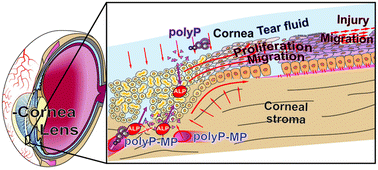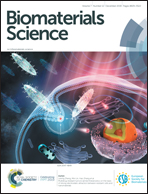Polyphosphate, the physiological metabolic fuel for corneal cells: a potential biomaterial for ocular surface repair
Abstract
The regeneration of the epithelium, covering the avascular cornea, involves the processes of differentiation, proliferation and migration of cells originating from the corneal epithelial stem cells. We ask the question if these energy-consuming processes can be fueled by the physiological, inorganic polyphosphate (polyP), the main energy storage/donor molecule in the extracellular space. The ex vivo results reveal that addition of polyP, in the form of soluble Na-polyP, to the culture medium elicits a strong stimulatory effect on cell viability/growth and migration of corneal epithelial cells. Microscopic analyses of partially denuded cornea specimens show that in the presence of polyP, but not in polyP-free controls, cells are migrating centripetally from the corneal limbus towards the corneal center. In vitro experiments using human corneal epithelial cells reveal an even stronger stimulatory effect on growth rates by calcium-polyP microparticles (Ca-polyP-MP) that mimic the physiological form of polyP in the platelets compared to particle-free Na-polyP, most likely by the transformation of Ca-polyP-MP into a biologically active coacervate. The increase in cell proliferation is paralleled with an increased expression of mucin 1. Our results suggest that polyP, in the form of the water-soluble Na-polyP, has the potential to be applicable as a biomimetic tear fluid to maintain and restore the integrity of the corneal epithelium.



 Please wait while we load your content...
Please wait while we load your content...